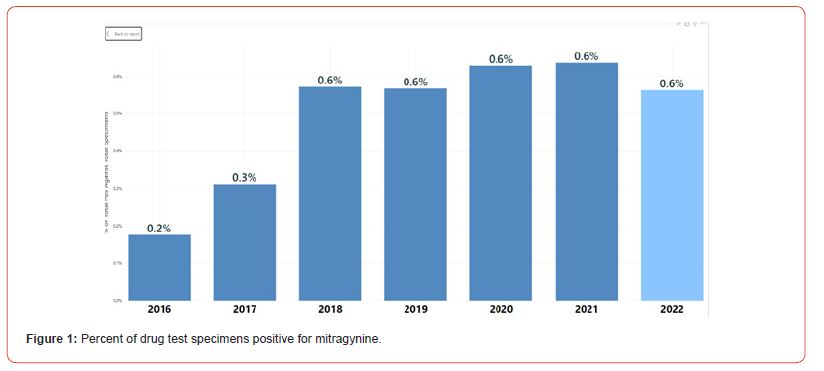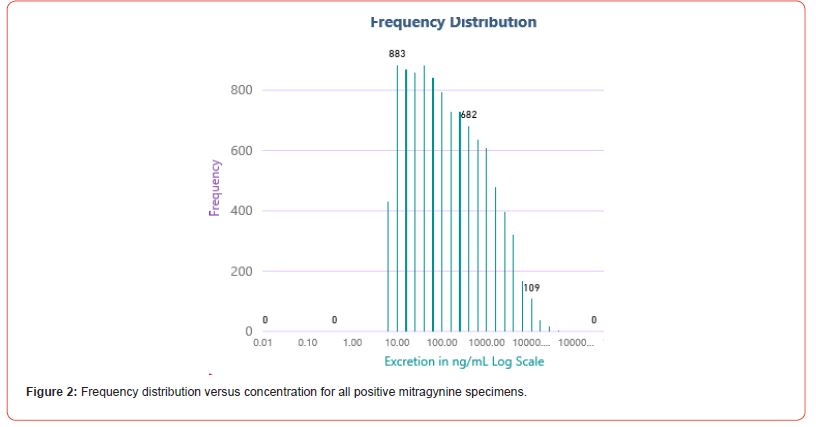 Letter to Editor
Letter to Editor
Observations on Mitragynine Use
Katie Bollman, Nallely Robles and Amadeo J Pesce*
Precision Diagnostics LLC, San Diego, CA, USA
Amadeo J Pesce, Professor, Precision Diagnostics LLC, 4215 Sorrento Valley Boulevard, San Diego, CA 92121, United States.
Received Date: February 13, 2023; Published Date: March 03, 2023
Abstract
Mitragynine is the principal alkaloid found in the leaves of Kratom (Mitragyna speciosa), a tropical tree indigenous to Southeast Asia Thailand, Malaysia, and Papua New Guinea. Mitragynine has become a drug of interest because of its increased use among substance abusers and patients seeking pain relief. Often the use of this drug is not disclosed by patients. In the 3,637,393 drug tests, performed on our monitored pain and substance abuse population over a seven-year period from April 2016 to November 2022, the frequency of observed use increased from 2016 to 2018 and then levelled off since that time. The median amount of drug in urine to be 95 ng/ml. We observed about a 31% coincident use of opioids, 22% use with benzodiazepines, and 20% with marijuana.
Background
Mitragynine is the principal alkaloid found in the leaves of Kratom (Mitragyna speciosa), a tropical tree indigenous to Southeast Asia Thailand, Malaysia, and Papua New Guinea [1]. Used by indigenous population historically as a stimulant to enhance stamina and reduce fatigue. The plant has been used for its psychoactive and analgesic properties throughout Southeast Asia since the 1800s. In South East Asia, Kratom is used as an antidiarrheal, a cough suppressant, an antidiabetic, an intestinal deworming agent and as a wound poultice. Most recently as an aid in treatment of heroin addiction.
Outside Asia, anecdotal use of Kratom preparations for the self-treatment of chronic pain and opioid withdrawal symptoms and as a replacement for opioid analgesics have been reported [2]. The raw leaves of the plant can be chewed, or dried and macerated to be smoked, steeped in tea, or encapsulated. These products are available through the internet as herbal plant material or extract [3].
Mitragynine has become a drug of interest because of its increased use among substance abusers and patients seeking pain relief. Often the use of this drug is not disclosed by patients with toxicologic symptoms making the cause of their symptoms difficult. Testing for the drug is possible because of recent advances in laboratories using LC-MS/MS and LC-TOF and the availability of appropriate standards.
The active ingredient, Mitragynine, is lipophilic and moderately permeable. Consumed orally, absorption is roughly 20% whereas complete bioavailability can be seen through intravenous administration [2]. When consumed at low doses stimulant effects are observed including increased energy, alertness, and euphoria. Larger doses produce opiate analgesia and sedation [4]. Mitragynine acts as an agonist via mu-opioid receptors. Administration of naloxone has been shown to block its opiate like effects [5]. The plant is used as a substitute for other opiates and to relieve the symptoms of opiate withdrawal. However, it can produce its own withdrawal symptoms including nausea, itching, aching, anorexia, insomnia, and psychological disturbance [2].
Currently various forms of Kratom such as leaves, (dried or crushed), extracts, powders, capsules, tablets, liquids, and gum/ resin are available on the internet. These products often advertise the stimulatory effect of kratom and that it has the benefit of counteracting opioid withdrawal.
Methods
The study was approved by ASPIRE IRB Santee CA. The analysis of 3,637,393 urines by the LC-MS/MS method of Krock et al [6], which included quantitative detection of mitragynine. The data was analyzed as described by Pesce et al [7].
Results
The test for mitragynine on the LCMS instruments were performed and determined positive with a cut off 5 ng/ml. For this study, the results specimens tested for mitragynine are shown. The increase in the use of mitragynine between April 2016 and November 2022 as a percentage of total specimens tested is illustrated in Figure 1. From 2016 to 2020 the percent of drug screens positive for mitragynine increased from about 0.2% to 0.6%, an overall increase of 3-fold. After this time until 2022, the frequency was unchanged. The frequency distribution curve presented in Figure 2 shows most of the observations were in the 10 to 100ng/mL range. However, because of the sharp drop-off at 5ng/mL, more patients were not included because they were below the cut off.


The urines are also tested for several opioids, benzodiazepines, delta 9-Tetrahydrocannabinolic acid (THCA) and illicit drugs such as fentanyl and cocaine (benzoylecgonine) [6]. This offered an opportunity to gain some insight into the mitragynine drug user habits. Of the 19,961 specimens positive for mitragynine, we observed that about 33 percent of mitragynine positive specimens were positive for the opioid’s morphine, oxycodone, and hydrocodone, and about 23 percent were also positive for benzodiazepine use., and 20% were positive for THCA. About 5.4% of the subjects used cocaine, while 4.5% percentage were positive for fentanyl (Table 1). These observations are consistent with other studies that show that the drug is valued for its opioidlike properties.
Table 1:Mitragynine and another drug use.

Discussion
Kratom is not currently scheduled under the Controlled Substances Act. However. the DEA has issued an advisory calling attention to dangers of its use listing it as a Drug and Chemical of Concern [4,8-11]. Kratom has not been approved by the FDA for any medical use. Legality has been left to state legislation with some states imposing regulation or prohibition against possession and use.
Several active components of kratom have been identified. Mitragynine is the most abundant alkaloid in the leaves with activity on μ, δ, and κ receptors. One of its main effects is on μ receptors creating opiate and analgesic effects and physical dependence. A second component of the leaves is 7-hydroxymitragynine which comprises about 2% of the alkaloids in the leaves and has a 13 to 46- fold higher potency than morphine and mitragynine, respectively [2].
There is concern that kratom overdoses can cause death. The CDC conducted a retroactive study of fatal overdoses from 27 states. That data included 27,338 deaths where 152 were kratom positive. Of those 152, 91 were determined to be caused by kratom. These estimates were probably low because post-mortem toxicology protocols for each state, county or city may not test for kratom [12].
The Food and Drug Administration (FDA) commissioner has stated that we must remain vigilant and aggressive against trends that threaten to reverse our progress as we deal with the devastating crisis of opioid misuse and overdose plaguing our nation [13].
He addressed the dangers associated with rise in the use of Kratom, addressing marketers making claims for therapeutic effects for products containing the plant commonly known as Kratom, a botanical with potential for abuse [12-15].
Acknowledgement
None.
Conflict of Interest
Author declared no conflict of interest.
References
- Ya, K, Tangamornsuksan W, Norman NC, Methaneethorn J, Lohitnavy M (2019) Pharmacokinetics of mitragynine, a major analgesic alkaloid in kratom (Mitragyna speciosa): A systematic review. Asian J Psychiatr 43: 73-82.
- Suhaimi FW, Yusoff NHM, Hassana R, Mansor SM, Navaratnama V, et al. (2016) Neurobiology of Kratom and its main alkaloid mitragynine. Brain Res Bull 126(Pt 1): 29-40.
- (2019) Kratom Drug Facts. National Institute of Drug Abuse.
- Drugs of Abuse 2020 Edition.
- Shamima, AR, Fakurazi S, Hidayat MT, Hairuszah I, Moklas Mohamad AM, et al. (2012) Antinociceptive Action of Isolated Mitragynine from Mitragyna Speciosa through Activation of Opioid Receptor System. Int J Mol Sci 13(9): 11427-11442.
- Krock K, Pesce A, Ritz D, Thomas R, Cua A, et al. (2017) Lower Cutoff for LC-MS/MS Urine Drug Testing. Pain Physician 20(7): E1107-E1113.
- Pesce AJ, Chandler N, Ackerman G (2021) Information Technology Structure for Urine Drug Testing Reports, 21st Century Pathol 1 (1): 103.
- Kratom Science.
- Prozialeck WC, Jivan JC, Andurkar SV (2012) Pharmacology of Kratom: An Emerging Botanical Agent With Stimulant, Analgesic and Opioid-Like Effects. J Am Osteopath Assoc 112(12): 792-799.
- Suhaimi FW, Yusoff NHM, Hassana R, Mansor SM, Navaratnama V, et al. (2016) Neurobiology of Kratom and its main alkaloid mitragynine Brain Res Bull 126(Pt 1): 29-40.
- Olsen EO, O'Donnell J, Mattson CL, Schier JG, Wilson N, (2019) Notes from the Field: Unintentional Drug Overdose Deaths with Kratom Detected - 27 States, July 2016-December 2017. MMWR Morb Mortal Wkly Rep 68(14): 326-327.
- Statement from FDA Commissioner Scott Gottlieb, M.D., on new warning letters FDA is issuing to companies marketing kratom with unproven medical claims; and the agency’s ongoing concerns about kratom.
- Kratom (2020) Department of Justice/Drug Enforcement Administration. Drug Fact Sheet.
- FDA and Kratom.






